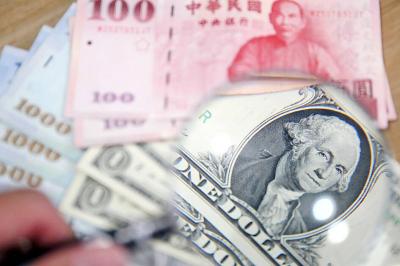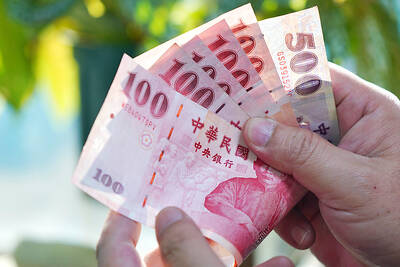China surpassed the US to become the world’s biggest trading nation last year as measured by the sum of exports and imports, a milestone in the Asian nation’s challenge to the US’ dominance in global commerce that emerged after the end of World War II in 1945.
US exports and imports last year totaled US$3.82 trillion, the US Commerce Department said last week. China’s customs administration reported last month that the country’s total trade last year amounted to US$3.87 trillion. China had a US$231.1 billion annual trade surplus, while the US had a trade deficit of US$727.9 billion.
China’s emergence as the biggest global trading nation gives it increasing influence, threatening to disrupt regional trading blocs as it becomes the most important commercial partner for countries including Germany, which will export twice as much to China by the end of the decade as it does to neighboring France, Goldman Sachs Group Inc’s Jim O’Neill said.
“For so many countries around the world, China is becoming rapidly the most important bilateral trade partner,” O’Neill, chairman of Goldman Sachs’ asset management division and the economist who bound Brazil to Russia, India and China to form the BRIC investing strategy, said in a telephone interview. “At this kind of pace by the end of the decade many European countries will be doing more individual trade with China than with bilateral partners in Europe.”
Still, the US economy is more than double the size of China’s, according to the World Bank. In 2011, the US’ GDP reached US$15 trillion, while China’s totaled US$7.3 trillion.
“It is remarkable that an economy that is only a fraction of the size of the US economy has a larger trading volume,” Nicholas Lardy, a senior fellow at the Peterson Institute for International Economics in Washington, said in an e-mail.
“The surpassing of the US is not because of a substantially undervalued currency that has led to an export boom,” Lardy said, adding that Chinese imports have grown more rapidly than exports since 2007.
China became the world’s biggest exporter in 2009, while the US remains the biggest importer, taking in US$2.28 trillion in goods last year, compared with China’s US$1.82 trillion in imports.
HSBC Holdings PLC forecast last year that China would overtake the US as the top trading nation by 2016.
While China is the biggest energy user, has the world’s biggest car market and the world’s largest foreign currency reserves, a significant portion of China’s trade involves importing raw materials and parts to be assembled into finished products and re-exported, an activity that provides “only modest value added,” Eswar Prasad, a former IMF official who is now a professor at Cornell University in Ithaca, New York, said in an e-mail.
The US’ bilateral trade deficit with China, which peaked last year, could remain a flashpoint of tension between the two countries, Prasad said.
“This trade imbalance is not representative of the amount of goods actually produced in China and exported to the US, but this perspective tends to get lost amidst the heated political rhetoric in the US,” Prasad said.
According to O’Neill, the trade figures underscore the need to draw China further into the global financial and trading architecture that the US helped create.
“One way or another we have to get China more involved in the global organizations of today and the future despite some of their own reluctance,” O’Neill said, mentioning China’s inclusion in the IMF’s Special Drawing Rights currency basket. “To not have China more symbolically and more importantly actually central to all these things is just increasingly silly.”

The US dollar was trading at NT$29.7 at 10am today on the Taipei Foreign Exchange, as the New Taiwan dollar gained NT$1.364 from the previous close last week. The NT dollar continued to rise today, after surging 3.07 percent on Friday. After opening at NT$30.91, the NT dollar gained more than NT$1 in just 15 minutes, briefly passing the NT$30 mark. Before the US Department of the Treasury's semi-annual currency report came out, expectations that the NT dollar would keep rising were already building. The NT dollar on Friday closed at NT$31.064, up by NT$0.953 — a 3.07 percent single-day gain. Today,

‘SHORT TERM’: The local currency would likely remain strong in the near term, driven by anticipated US trade pressure, capital inflows and expectations of a US Fed rate cut The US dollar is expected to fall below NT$30 in the near term, as traders anticipate increased pressure from Washington for Taiwan to allow the New Taiwan dollar to appreciate, Cathay United Bank (國泰世華銀行) chief economist Lin Chi-chao (林啟超) said. Following a sharp drop in the greenback against the NT dollar on Friday, Lin told the Central News Agency that the local currency is likely to remain strong in the short term, driven in part by market psychology surrounding anticipated US policy pressure. On Friday, the US dollar fell NT$0.953, or 3.07 percent, closing at NT$31.064 — its lowest level since Jan.

The New Taiwan dollar and Taiwanese stocks surged on signs that trade tensions between the world’s top two economies might start easing and as US tech earnings boosted the outlook of the nation’s semiconductor exports. The NT dollar strengthened as much as 3.8 percent versus the US dollar to 30.815, the biggest intraday gain since January 2011, closing at NT$31.064. The benchmark TAIEX jumped 2.73 percent to outperform the region’s equity gauges. Outlook for global trade improved after China said it is assessing possible trade talks with the US, providing a boost for the nation’s currency and shares. As the NT dollar

The Financial Supervisory Commission (FSC) yesterday met with some of the nation’s largest insurance companies as a skyrocketing New Taiwan dollar piles pressure on their hundreds of billions of dollars in US bond investments. The commission has asked some life insurance firms, among the biggest Asian holders of US debt, to discuss how the rapidly strengthening NT dollar has impacted their operations, people familiar with the matter said. The meeting took place as the NT dollar jumped as much as 5 percent yesterday, its biggest intraday gain in more than three decades. The local currency surged as exporters rushed to